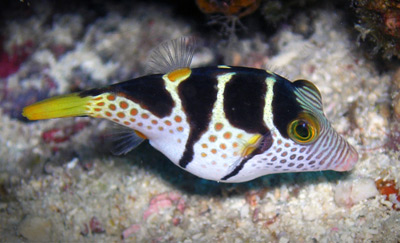Sometimes good things come in small packages. Such is the case with Canthigaster valentini, better known as the saddled toby, black-saddled toby, or Valentin’s toby (you may also see “sharpnose puffer” substituted for “toby” in various sources). Reaching only about 4 inches in total length and usually adapting well to aquarium conditions, this species can make a great choice for puffer aficionados with modest-sized systems and an intermediate level of hobby experience.
Physical traits
It’s hard to do justice to the saddled toby’s physical appearance with a written description, but I’ll give it a whack: This fish is somewhat laterally compressed with high-set eyes and a moderately elongated snout (hence the “sharpnose” moniker). White in base coloration, it has a series of brown markings along its back, the two in the middle extending downward to the belly. Small orange to brown spots appear all along the ventral half of the fish, and the face is scrawled with thin, brownish lines.
Adult males tend to be larger than females and can be distinguished by the presence of thin, turquoise lines originating on the head and extending along the back. There are other distinguishing characteristics as well, but this feature is probably the easiest to recognize at a glance.
Being a puffer, C. valentini does have the ability to inflate its body when threatened. This response is very stressful to the fish and should never be encouraged. To avoid stressing a specimen when moving it from one tank to another, gently coax it into a rigid container instead of attempting to capture it by net.
The sincerest form of flattery
It’s noteworthy that C. valentini has a mimic species, known as the saddled filefish (Paraluteres prionurus), that is nearly identical to the toby in shape, coloration, and patterning. What does P. prionurus gain from this mimicry? Well, C. valentini has a deadly toxin, known as tetrodotoxin, in its tissues, which discourages predation—and looking poisonous can be just as effective a predator deterrent as actually being poisonous.
The visual difference between these two species is quite subtle—C. valentini has a single dorsal spine while P. prionurus has two dorsal spines—so if you go to buy one, make sure you’re getting what you think you’re getting. That said, I should point out that P. prionurus actually makes a very good aquarium candidate in its own right.

Feeding
C. valentini feeds on benthic invertebrates as well as filamentous and coralline algae in nature, so a varied menu suited to omnivores is required in captivity. Also, hard-shelled foods (e.g., small bivalve mollusks and crustaceans with exoskeletons) must be offered routinely to help this little puffer wear down its constantly growing teeth. Otherwise—and without purposeful trimming on the hobbyist’s part—they may grow to the point that the fish cannot eat properly and will starve to death.
Housing
I’ve seen minimum tank recommendations as small as 20 gallons for this species, but I wouldn’t advise going much lower than 30 gallons. Though C. valentini is a pint-sized puffer and doesn’t need a great deal of swimming space, it’s a messy feeder and heavy waste producer, so it helps to provide a little more dilution for all that pollution.
Compatibility
In choosing tankmates, keep in mind that C. valentini can be a fin nipper and has the dentition to do some serious damage if so inclined. Species with long fins or filaments should definitely be avoided. Conspecifics (with the possible exception of keeping a known mated pair in a larger system) and congeners are also poor choices, as they are likely to elicit aggression. Apart from that, C. valentini will tend to get along with most other fish species (discounting any that might harm the toby, of course), but keep an eye out for aggressive behavior in any case. In smaller systems, I would suggest keeping a single specimen by itself.
Also, I would think twice before including this or any toby in a reef system. Depending on the invertebrate species kept, it may work out, but I would not consider C. valentini to be reliably reef safe.



